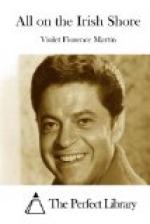this narrow trench and a low, rotten fence, and the
fool behaved as though she wanted to jump it all.
I hope no one will ever erect an equestrian statue
in my honour; now that I have experienced the sensation
of ramping over nothing, I find I dislike it.
I believe I might have been there now, but just then
a couple of hounds came up, and before I knew what
she was at, the filly had jumped down after them into
the trench as if she had been doing it all her life.
I was not long about picking the others up; the filly
could gallop anyhow, and we thundered on over ground
where, had I been on foot, I should have liked a guide
and an alpenstock. At intervals we jumped things
made of sharp stones, and slates, and mud; I don’t
know whether they were banks or walls. Sometimes
the horses changed feet on them, sometimes they flew
the whole affair, according to their individual judgment.
Sometimes we were splashing over sedgy patches that
looked and felt like buttered toast, sometimes floundering
through stuff resembling an ill-made chocolate souffle,
whether intended for a ploughed field or a partially
drained bog-hole I could not determine, and all was
fenced as carefully as cricket-pitches. Presently
the hounds took a swing to the left and over the edge
of the hill again, and our leader Jerry turned sharp
off after them, down a track that seemed to have been
dug out of the face of the hill. I should have
liked to get off and lead, but they did not give me
time, and we suddenly found ourselves joined to Robert
Trinder and his company of infantry, all going hard
for the oak wood that I mentioned before.
It was pretty to see the yellow horse jump. Nothing
came amiss to him, and he didn’t seem able to
make a mistake. There was a stone stile out of
a bohireen that stopped every one, and he changed feet
on the flag on top and went down by the steps on the
other side. No one need believe this unless they
like, but I saw him do it. The country boys were
most exhilarating. How they got there I don’t
know, but they seemed to spring up before us wherever
we went. They cheered every jump, they pulled
away the astounding obstacles that served as gates
(such as the end of an iron bedstead, a broken harrow,
or a couple of cartwheels), and their power of seeing
the fox through a stone wall or a hill could only be
equalled by the Roentgen rays. We fought our way
through the oak wood, and out over a boggy bounds
ditch into open country at last. The Rioters
had come out of the wood on a screaming scent, and
big and little were running together in a compact
body, followed, like the tail of a kite, by a string
of yapping country curs. The country was all grass,
enchantingly green and springy; the jumps were big,
yet not too big, and there were no two alike; the
filly pulled hard, but not too hard, and she was jumping
like a deer; I felt that all I had heard of Irish
hunting had not been overstated.
We had been running for half an hour when we checked
at a farmhouse; the yellow horse had been leading
the hunt all the time, making a noise like a steam-engine,
but perfectly undefeated, and our numbers were reduced
to five. An old woman and a girl rushed out of
the yard to meet us, screaming like sea-gulls.




